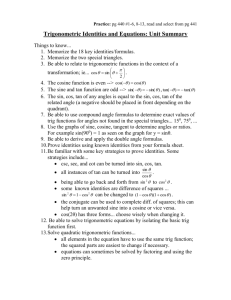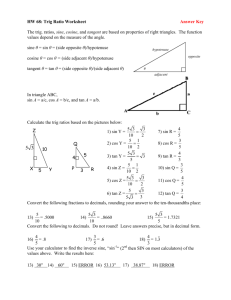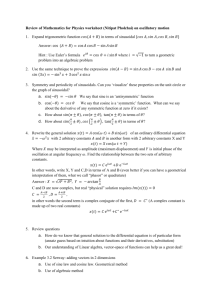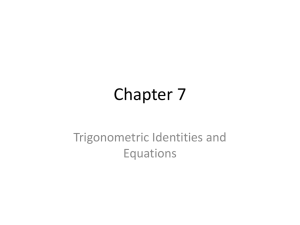Discovering New Trig Identities
advertisement
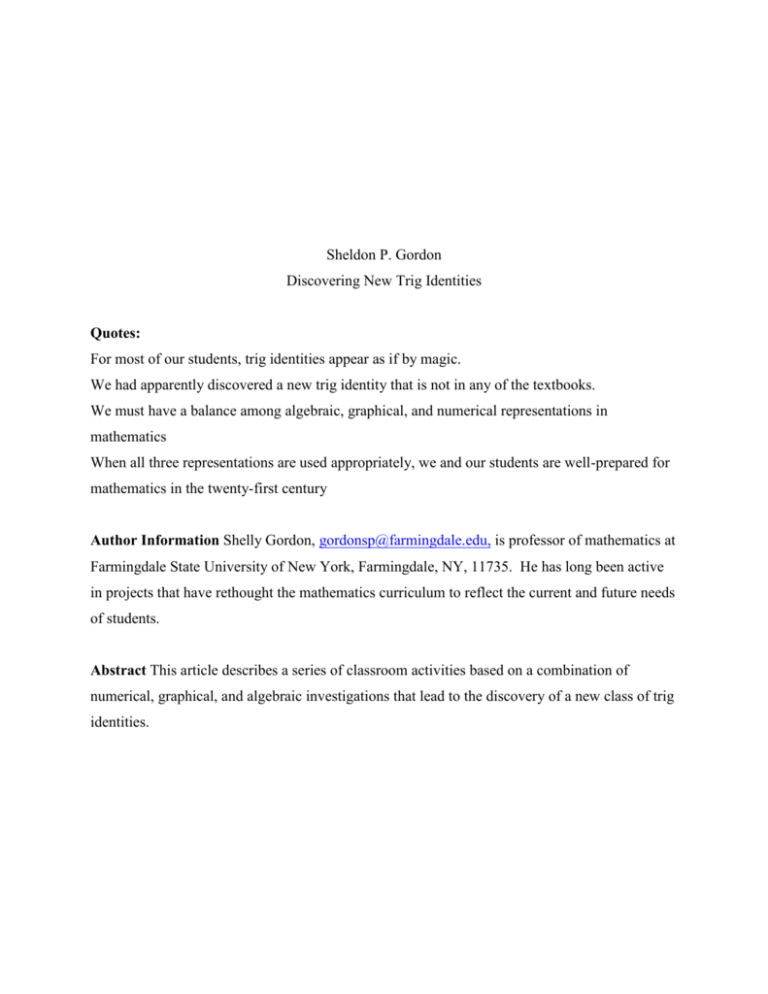
Sheldon P. Gordon Discovering New Trig Identities Quotes: For most of our students, trig identities appear as if by magic. We had apparently discovered a new trig identity that is not in any of the textbooks. We must have a balance among algebraic, graphical, and numerical representations in mathematics When all three representations are used appropriately, we and our students are well-prepared for mathematics in the twenty-first century Author Information Shelly Gordon, gordonsp@farmingdale.edu, is professor of mathematics at Farmingdale State University of New York, Farmingdale, NY, 11735. He has long been active in projects that have rethought the mathematics curriculum to reflect the current and future needs of students. Abstract This article describes a series of classroom activities based on a combination of numerical, graphical, and algebraic investigations that lead to the discovery of a new class of trig identities. Discovering New Trig Identities For most of our students, trig identities appear as if by magic. A recent class activity gave me the rare opportunity to lead my students to discover what appears to be a new trig identity by using a combination of graphical, numerical, and algebraic tools. In this article, I will demonstrate this result and then show how it can be extended, during a subsequent class, to a wider class of apparently new identities that are all extensions of the Pythagorean identity. The initial class activity began with a refresher on the Pythagorean identity sin2 x + cos2x = 1 . To make the point about what a trig identity is, I had the students use their graphing calculators to graph the function y = sin2x + cos2x. The result, a horizontal line, made a dramatic impact on the students about the significance of what an identity actually is – in this case, an equation that holds for every value of x. For comparison, I asked them to graph, on the interval [0, 2], both y = sin3x + cos3x, as shown in Figure 1, and y = sin4x + cos4x, as shown in Figure 2. Neither is the horizontal line that the initial exploration with y = sin2x + cos2x had some of the students expecting. 3 4 4 Graph of y =sin x + cos x 3 Graph of y =s in x + cos x y 1 1 y 0.5 0 x -0.5 2 -1 0.5 x 0 -1.5 2 1 2 One student observed that the curve for y = sin4x + cos4x in Figure 1 looked like a sinusoidal graph. This seemed to be too good an opportunity to pass up, so I decided to lead a discussion about what kind of curve this could be. The shape clearly suggested a cosine curve, but one that completed four full cycles between 0 and 2, so that it had an apparent period of /2 and therefore a frequency of 4. The graph also suggested that the basic cosine curve had been squeezed and shifted upward. I asked the students to zoom in on the curve and trace it until they could determine the heights of the turning points. These turned out to be approximately 1 for the maxima and ½ for the minima, suggesting that the vertical shift is ¾ and that the amplitude is ¼. Thus, our conjectured formula for the function observed was y = ¾ + ¼cos 4x. A little graphical exploration seemed to confirm the conjecture that sin4x + cos4x = ¾ + ¼cos 4x, (1) since the two graphs are indistinguishable. Thus, we had apparently discovered a new trig identity that is not in any of the textbooks. Of course, such a graphical analysis does not prove that it is indeed an identity. Several weeks later, when the class had a greater collection of trig identities at their disposal, I came back to this issue to see if we could prove the conjectured result analytically. Starting with the left-hand side of equation (1), we repeatedly apply the half-angle identities for sine and cosine to get 44 xx sincos xx 1cos21cos2 22 22 11 2 cos2x 22 1cos4 x 11 222 = = ¾ + ¼cos 4x. Alternatively, we could start with the right-hand side of the conjectured identity and apply the double angle identities for the cosine. This approach is complicated by the fact that there are different forms for the identity, each leading to a different, albeit algebraically equivalent, derivation. We illustrate one route. ¾ + ¼cos 4x = ¾ + ¼(2cos2 2x - 1) = ½ + ½cos22x = ½ + ½[1 - 2sin2x]2 = ½ + ½[1 - 4sin2x + 4sin4x] = 1 - 2 sin2x + 2sin4x. = (1 - 2 sin2x + sin4x) + sin4x 6 6 Graph of y =sin x + cos x 8 1 0.5 8 Graph of y =sin x + cos x y 1 2 = (1 - y sin2x)2 + sin4x 0.5 = cos4x + x 0 x 0 sin4x. 2 2 4 Thus, the conjectured result is indeed an identity. Having established that (1) is indeed an identity, it is natural to wonder whether comparable identities arise for other values of n in y = sinnx + cosnx. We have already seen from Figure 1 that the case n = 3 does not yield a 2cos x 4 simple sinusoidal curve. Figure 3 Graph of y =sin x + cosx y 1.5 1 0.5 shows the graph of y = sin x + cos x 0 x with n = 1, which does suggests a simple sinusoidal -0.5 curve that is shifted and stretched. A graphical -1.5 2 -1 investigation indicates that the function is based on a cosine function with a phase shift of /4 and an 3 amplitude of slightly less than 1.5. A little further investigation shows that the amplitude is actually slightly more than 1.4, which suggests that the correct value is and therefore that sin x + cos x = . Expanding the right-hand side easily confirms that this is indeed true. However, let’s focus on the cases n = 6, 8, 10, ... in y = sinnx + cosnx with even powers. We show the graphs of the first three of these cases between x = 0 and x = 2 in Figures 4, 5, and 6 respectively and observe that each appears to be a relatively simple sinusoidal function. First, notice that in each case, the period appears to be /2, so that the frequency appears to be 4 in each case. To prove that this is indeed the case, notice that, when n is even, sinn (x - /2) + cosn (x - /2) = [-cos x]n + [sin x]n = cosn x + sinnx, so that the period of f(x) = sinnx + cosnx is at most /2. Based on 10 10 Graph of y =sin x + cos x the graphical evidence in Figures 2, 4, 5, and 6, we conclude that 1 the period is exactly /2 when n = 4, 6, 8, and 10. (It is conceivable that the period might be smaller than /2 for larger, y 0.5 even values of n.) x 0 Let’s continue with the case n = 6. The observed 2 5 6 oscillations in Figure 4 range from an apparent minimum of ¼ to an apparent maximum of 1 and so we might conjecture that the corresponding relationship is sin6x + cos6x = 5/8 + 3/8 cos 4x. (2) An algebraic derivation similar to what we did above with n = 4 shows that this is true for all values of x and so equation (2) is indeed an identity. When we repeat this process with n = 8 and trace the resulting graph, we find that the oscillations appear to range from 1/8 to 1, which suggests the possible relationship cos8x + sin8x = 9/16 + 7/16 cos 4x. When the two functions y = cos8x + sin8x and y = 9/16 + 7/16 cos 4x are both displayed on the interval from 0 to 2, the match appears perfect to the naked eye. However, when we examine a table of values for the two functions, we find that there are some fairly significant discrepancies that are more than just rounding errors, as seen in the following table for x = 0, /50, /25, ... . x sin8x + cos8x 9/16 + 7/16 cos 4x 0 1 1 /50 0.984322 0.986255 2/50 0.938631 0.945884 3/50 0.866780 0.881424 4/50 0.774646 0.796924 5/50 0.669429 0.697695 If you zoom in on the graph several times, you eventually will see these discrepancies visually as well. A better way to see them clearly is to examine the graph of the difference, y = sin8x + cos8x - (9/16 + 7/16 cos 4x), which is shown in Figure 7 with a vertical range from -0.04 to 0.01. To determine what’s happening, let’s go back to the trig identities. We start with sin8x + cos8x and repeatedly apply the half-angle y =sin 8 x + cos 8 x - ( 9/16 + 7/16 cos 4x) y 44 0.01 88 x x sincos xx 1cos21cos2 2 2 2 0 x -0.01 identities for the cosine to get -0.02 -0.03 -0.04 24 1 212cos22cos2 xx 16 7 1cos4 x 2 1 13 1cos4 x 8 2 = 2 = 1 1 134 1cos412cos4cos x x x 4 8 = 1cos8 x 1 1 13 x x 1cos412cos4 4 82 357 cos 4cos x 1 8x 641664 =. Since these steps are reversible, we have proved the identity 357 cos4 x 1 cos8x 641664 321 sin8x + cos8x = . (3) Incidentally, the graph in Figure 7 suggests that the difference between y = sin8x + cos8x and y = 9/16 + 7/16 cos 4x is a sinusoidal function with a period of apparently /4 and an associated frequency of 8. The curve oscillates between roughly 0 and -0.03125, as can be found if you trace its graph on a calculator. But -0.03125 =. Therefore, we can conjecture a formula for the “difference” as the sinusoidal 11 x function 6464cos(8) sin8x + cos8x - (9/16 + 7/16 cos 4x) = , so that, after a little simplification, we again obtain 357 cos4 x 1 cos8x 641664 sin8x + cos8x = , and so our conjecture is true. Using the same combination of graphical, numerical, and algebraic reasoning, we also have the identity 1010 63155 sincos xx cos4 x cos8x 12832128 . So far, we have only discussed the situation where n is even. Consider again the case with n = 3, so that we have the function y = sin3x + cos3x. Clearly, this expression cannot be simplified using the half-angle formulas, as we did above with the even powers. The graph of this function, in Figure 1, certainly suggests a function with a period of 2. Moreover, the graph may also suggest that the function is composed of the sum of several sinusoidal functions. We leave that investigation to the interested reader. It might make a wonderful exploratory exercise for some highly motivated students to have them construct a formula involving sines and cosines with multiple angles instead of powers of the sine and cosine to match the graph. One moral to this story, clearly, is that we must have a balance among algebraic, graphical, and numerical representations in mathematics. An overriding emphasis on symbolic manipulation, as in traditional math classes, means that these new identities would never have been found. Worse, students would only be moving symbols around without any understanding of what is happening or an appreciation that mathematics is an exploratory subject with a huge premium on discovering new results. But, an overriding emphasis on graphical analysis can give misleading or false results. When all three representations are used appropriately, we and our students are well-prepared for mathematics in the twenty-first century. Acknowledgments The author gratefully acknowledges the support for the work described in this article under grant #DUE-0089400 from the Division of Undergraduate Education of the National Science Foundation. However, the views expressed are not necessarily those of either the Foundation or the project. The author also gratefully acknowledges some particularly insightful suggestions made by one of the referees.

